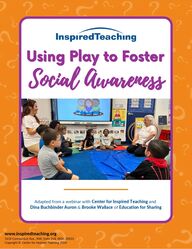
Return to flip book view
Message Using Play to FosterUsing Play to Foster Social AwarenessSocial Awarenesswww.inspiredteaching.org 5614 Connecticut Ave., NW, Suite 258, WDC 20015Copyright © Center for Inspired Teaching 2024Adapted from a webinar with Center for Inspired Teaching and Dina Buchbinder Auron & Brooke Wallace of Education for Sharing
Play is not the enemy of seriouslearning. It’s actually the catalyst.- Dina Buchbinder Auron, Founder and President of Education for SharingIn an increasingly connected world, it is more important than ever forstudents to develop social awareness, a capability CASEL defines as“understanding the perspectives of and empathizing with others,including those from diverse backgrounds, cultures, and contexts.”During our recent webinar, Cultivating Curiosity: Raising SocialAwareness, Dina Buchbinder Auron and Brooke Wallace ofEducation for Sharing (E4S) joined us to discuss their approach toraising better global citizens through the power of play.What is social awareness?School is serious work, and play is where serious learning takesplace. Play creates a space where children naturally explore andconnect ideas. It goes beyond board games and recess; play canbe infused into every lesson to create more thoughtful,empathetic students. What is play?www.inspiredteaching.orgCopyright © Center for Inspired Teaching 20242
Play is being present. Play is being here and now.We enter into a space where everything is possibleand our sense of wonder and possibility is awakened.- Dina Buchbinder Auron, Founder and President of Education for Sharingwww.inspiredteaching.orgCopyright © Center for Inspired Teaching 20243When children learn through play, they are learning throughexperimentation — without the fear of failure. They are buildingIntellect and Imagination, two of Inspired Teaching’s 4I’s andcornerstones of everything we do. Center for Inspired Teaching was named a LEGO Champion ofPlay for putting the power of play and the student’s imagination atthe heart of learning. Watch our video here.
REFLECTAfter playing a few rounds of the game, prompt studentsto reflect on their experience with questions like these:What does it mean to lead and follow?How did it feel being the guide/shadow?How would you feel if someone was chosen to bethe leader and felt a little scared?Reflection is a moment in which studentsexchange ideas and opinions, learn tolisten, resolve conflicts, while they usedialogue as a tool to learn and share.www.inspiredteaching.orgCopyright © Center for Inspired Teaching 2024*Source: Education for Sharing websitePlay is our brain’s favorite way to learn! It creates a space for students of all ages to explore and connect ideasthat can make learning a more holistic, meaningful, and joyfulexperience. When playing, students learn essential life skills—such ascooperation, collaboration, strategy, negotiation, and empathy—thatcan’t be gained from memorization alone. As a result, they becomemore thoughtful global citizens. This is the core idea of the Educationfor Sharing methodology: Play / Reflect / Act.Below, we'll walk through E4S’ Play / Reflect / Act* using their game,"Shadow, Shadow."Why is play important?4PLAYActive learning through play transformsthe educational experiences of students,and at the same time, strengthens theircognitive, motor, social and emotionaldevelopment.Shadow, Shadow is a game in which one student isthe designated "guide,” and the remaining studentsare the "shadow." The guide demonstrates an actionor movement and the shadows will mimic them.Students can take turns being the guide.ACTEncourage students to use their reflections to considerhow they can take meaningful action with questionssuch as these:What did you learn today?What would you like to do differently?Students are encouraged to seethemselves as agents of change, able towork as part of a team with theircommunity and implement local actions to transform their environment at thesame time as they generate global impact.
Inspired Teachers are always looking for ways to bring new strategiesand activities into their practice! Here are four more activities that canbuild social awareness in the classroom.4 Ways to Incorporate MorePlay in Your Classroomwww.inspiredteaching.orgCopyright © Center for Inspired Teaching 20245Because emotions are intangible andvery personal, it can be hard to findthe vocabulary to talk about them. Thisactivity offers students the chance topractice mapping their emotions ontosomething more concrete–color–andthen discuss them.Using basic observation and listeningskills, this activity can serve as a catalystfor building community in the classroomand deepening understanding of howeach of your students thinks. Coloring OurEmotionsWhen students enter the classroom,they bring various emotions that impactboth themselves and their peers. Theseactivities can help you assess the overallmood right away and help youunderstand what you’re working with.This activity invites to students tonotice the role our imagination plays inunderstanding other people, and howwe all perceive things differently.Check theMood of the RoomSeeing withDifferent EyesListening withSomeoneElse’s Ears
www.inspiredteaching.orgCopyright © Center for Inspired Teaching 2024About Us6Center for Inspired Teaching providestransformative, improvisation-basedprofessional learning for teachers that is100% engaging—intellectually, emotionally,and physically. We teach teachers how tobuild a practice where students areempowered to be empathetic criticalthinkers, prepared to tackle the complexissues of today and tomorrow, whileaddressing standards and meeting goals.Education for Sharing (E4S) is aninternational non-profit organization thatforms better global citizens throughinnovative education based on the power ofplay. They partner with schools, doprofessional development, workshops, anddesign curricula where educatorsexperience firsthand how play can translateabstract concepts into very concrete andrelatable experiences.Join Inspired Teaching for future professional development programslike the Cultivating Curiosity: Raising Social Awareness . Learn more.